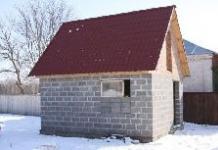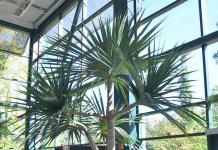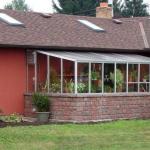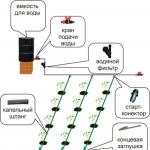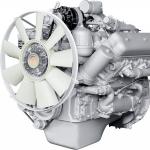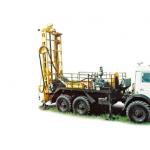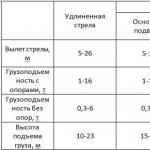Traditionally in our country, the kitchen is not only a place where food is prepared, but also a place for eating and private gatherings. Therefore, the lighting in the kitchen should be not only practical, but also beautiful and comfortable.
Principles and requirements
A kitchen is a room in which there are at least two zones with different purposes - a working area for cooking and a dining area. From different purposes, different requirements for lighting the kitchen follow: in the working area there should be bright lighting that allows you to see everything clearly, and in the dining area - softer.
But zoned kitchen lighting does not exclude the presence of a chandelier. Its functional significance is small, since the light spot is obtained in the center of the room, which remains mostly empty. But from the point of view of leveling uneven illumination, this method is very good. Alternatively, you can use several spotlights, as in the photo above, or install built-in ceiling lights if the ceiling is stretched or suspended from.
It is necessary to think about lighting the kitchen even at the repair stage, when it is assembled, the wiring is pulled, the places for installing sockets and switches are marked. Later, after the repair is completed, it is very problematic to do this - you have to lay the wiring on top or in.
Illumination standards
When you are just planning lighting in the kitchen, the question arises of how many fixtures are needed and how much power. It's simple: there are lighting standards for each room for the kitchen, this is 150 Lux per square meter. Considering the illumination in Watts is no longer relevant, since a 7 W LED lamp can produce light like a 50 W incandescent lamp or 650 Lm.
For example, let's calculate how much light is required for a 12 m2 kitchen. To do this, we multiply its area by the norm: 12 m2 * 150 Lx = 1800 Lx. And since 1 Lux is equal to 1 Lumen, it is necessary to install light bulbs, which in total give at least 1800 Lm.

If you decide to do zoned lighting, that is, the work surface will be illuminated separately, there will be your own light source above the table, it makes sense to count everything separately. To do this, the kitchen plan must be divided into zones, calculate the area and, based on these figures, select the number of lamps and lamps for them. Just keep in mind that two 50W lamps in total will not give as much light as one 100W lamp, but about 1/3 less.
Lamp type, color and light
Another important point. When choosing lighting, it is best to choose the same type of lamps: halogen, LED, daylight. In extreme cases, you can combine the two types, but it is better not to use all three. They give different lighting and it is almost impossible to get a sane result. We are not talking about incandescent lamps, since they are already used very rarely: they require too much electricity, giving out a small amount of light.

In addition to the type of lamps, it is necessary to choose lamps that give light of the same color, which is also called the color temperature of the lamps. They can give light with a blue, yellow, white tint. In principle, you choose, but the best option is natural or neutral. It is better for the eyes and for the perception of colors.
General lighting in the kitchen
Now let's figure out how to make general lighting in the kitchen. The traditional option is a chandelier. But it does not fit into every modern interior, however, it has a place to be.

Traditional general lighting - a chandelier in the middle of the ceiling
Often kitchens are not square, but rectangular in shape. In this case, you can find a chandelier, elongated in length. For a long and narrow room, this is the best option, which will provide optimal light distribution.

With low ceilings, it will not be possible to hang a chandelier - it will interfere. The way out is to find the lamp almost flat. It can be square or round - which one is more suitable for the selected one.

If you are going to make a suspended or stretch ceiling, you can “scatter” spotlights over the surface or create some kind of pattern from them (read about how to place spotlights and more). You can also make the backlight around the perimeter of the "central" zone. Such lighting in the kitchen visually helps to raise the ceiling, making the room a little more spacious.

All these methods can be combined, so the number of options is very large. But it is important not to forget that there is still lighting for two other zones and look for lighting fixtures for her at once, because they must match in style.
Dining area lighting
The light near the dining table can be made in just two variations: a sconce story, one or more lamps on a long cord from the ceiling.

You can use the sconce if the table is near the wall. When choosing the location of a wall lamp, there are two considerations: the degree of illumination and convenience. The lamp should not interfere, for which it is placed at a height of 60-80 cm above the table top. In order for it to illuminate the entire table, it is advisable to find a model that allows you to bring the ceiling away from the wall.

To ensure that the lighting in the kitchen is not only bright, but also beautiful, all lamps, chandeliers, sconces are selected in the same style, which should also be in harmony with the overall design style.
Work surface illumination
There are more nuances in lighting the working area in the kitchen. First of all, you need to decide where to place the fixtures, then choose their type, type and shape of the lamps.

Location selection
When illuminating the working area in the kitchen, lamps are usually placed on the underside of hanging cabinets. And this is the best possible option. Because everyone else is much worse. For example, if the light source is on the ceiling (position 1 in the photo), standing with your back to it you block the light. Even in the event that the lamps are located along the line, but high - on the ceiling or slightly above the level of the upper cabinets (position 2) - only a narrow part of the working surface from the edge is illuminated, the rest is in the shade. Therefore, the illumination of the working area in the kitchen is done by fixing the lighting fixtures at the bottom of the cabinets. Then the lighting in the kitchen has a pronounced zonal character, but it is much more convenient to work this way.

Here again there are options: the lamps can be placed closer to the wall, in the middle, closer to the outer edge of the cabinets. The best option is closer to the outer edge (position 4). So the lighting is most effective with fewer shadows in the work area. The third option is also good. It is somewhat worse in terms of illumination, but more practical in implementation.
So that the lighting in the kitchen does not interfere
If the illumination of the working surface in the kitchen is done at the bottom of the cabinets, other problems arise:
- Not everyone is satisfied with the appearance of the lamps attached in this place.
- The light hits the eyes of people sitting at the table.
Both of these problems have one solution: it is necessary to put a decorative bar that will cover the lamp and limit the spread of light. It turns out that the lighting in the kitchen is softer and the lighting fixtures themselves are not visible.

The location of the bar, its height, the position of the lamp must be selected on the spot: light sources have different heights, different brightness, the luminous flux can also be directed in different ways. Therefore, you select the parameters of the bar experimentally. Ideally, if the light does not fall even on the floor, but will only illuminate the countertop.
Alternatively, the bar can be designed as a small shelf for various kitchen trifles. Usually decor or jars of spices are displayed here. If you don't like this idea, just do the plank. If you think that even the plank spoils the look or it just doesn’t fit into the style, make a double bottom in the cabinets, hiding the light sources inside. In this case, you can install frosted glass, which will soften the light.

The door in this case is made along the entire length, although this is not necessary. In order to avoid problems with fastening the glass, an aluminum corner can be installed around the bottom perimeter, on which you can simply lay a piece of frosted glass or translucent polycarbonate cut to size.
Spot lighting
When organizing lighting in the kitchen in the working area, you immediately need to decide what type of light sources you will use. There are two options - point and tubular. In the case of using spotlights, it turns out such a “zebra”, the contrast of which can be negated by more frequent installation of light bulbs.

The advantage of this solution is that the lamps are quite decorative and such lighting looks beautiful. Minus - it is not always convenient when cooking. Another drawback: spotlights are quite high and they can only be installed with a second bottom in the cabinets.

If you choose this way to make lighting in the kitchen, take LED lamps. Now they are the most economical - with low power consumption they give a lot of light, they last a long time. In this case, their undoubted plus is that they practically do not heat up, so nothing threatens the furniture. The option is a little worse - halogen lamps (they heat up, "pull" a little more electricity), even less economical - fluorescent lamps with a conventional cartridge, and the most unfortunate - incandescent lamps.
Linear light sources
When using linear fixtures, the illumination is almost uniform, since the lighting fixtures can be mounted with a distance of a couple of centimeters between them.

When choosing light sources for linear lighting, there are even more options and the range is expanding all the time. Perhaps there are already new tools that few people know about yet. In the meantime, there are three of them: LED strip, LED and fluorescent lamps. There is also neon lighting, but it is quite difficult to install, and it costs more. Therefore, lighting in the kitchen with neon tubes or flexible hoses is almost never done.
LED Strip Light
Tape and LEDs can be mounted simply on furniture, as it has a sticky layer. But this layer is unreliable, therefore they prefer to fix it in some way - with double tape, staples from. If you intend to fix the tape directly on the furniture, choose models with a high level of protection - IP44 and higher. But it is better not to take those that are soldered in a tube - at home they overheat (especially in the kitchen), quickly fade, and soon burn out. For this case, it is better to take types filled with varnish or other protective composition.

When choosing an LED strip to illuminate the work surface in the kitchen, you need to pay attention to the brightness and size of the crystals. You need to choose the largest 50 * 50 or 50 * 75, and it is better if they are arranged in two rows. Their total power should give no less light than determined in the calculations. Read about the types of LED strips and the rules for their installation.
You can install the LED strip in special profiles (they are also called cable channels or trays). They are usually made of aluminum and have a transparent or translucent removable front panel. Inside there may be a shelf on which the tape itself is attached. These are the most convenient types, while others have to be tricky.

The advantages of installing LED backlight in such a tray - there is no point in worrying about the degree of protection of the tape, a decent appearance. The disadvantage is less bright light, so the power of the crystals must be greater than the calculated one. In any case, lighting in the kitchen using LED strips is becoming more and more popular. The reason for this is ease of installation and low power consumption.
LED kitchen lighting
LED lamps can be not only point or conventional - in the form of a pear with a standard base. There are also tubes.

They are mounted on clips - plates that are mounted on furniture, into which tubes are inserted. Some can be mounted on magnets. Reciprocal metal plates are attached to the furniture (you can use double-sided tape), and the lamps are simply attracted to them due to the magnets built into the body (Sensor model).
Fluorescent lamps
Tubular fluorescent lamps are a traditional way of lighting. They are good because they are switched on directly to 220 V, while LED ones require a special adapter that will give the required voltage.
Disadvantages have been known for a long time - the pulsation of light, which negatively affects the eyes. There is one more not very pleasant moment: LEDs are more economical. They consume very little electricity and last longer. Their service life is estimated in thousands of hours. Fluorescent lamps have to be changed much more often (every five), but they cost less. In general, it is up to you what type of lamp you want to use when lighting the kitchen.

Fluorescent lamps for kitchen lighting can be stylish
If you decide to light the kitchen with fluorescent lamps, the optimal size is the G13 base (diameter 26 mm). In length, they can be 60 cm, 90 cm, 120 cm, 150 cm. There are different models today - from the usual to quite pretty ones (as in the photo above).
It is possible, as mentioned above, to hide such lamps in a double bottom by installing light-scattering glass. In this case, you can buy the most inexpensive lamps. But it is unlikely that it will be possible to save money - the costs for the profile for installing glass and the glass itself are either equivalent or may even turn out to be more.

As you can see, lighting in the kitchen is better to do multi-zone, and at the moment it is better to use LEDs. Lamps are quite expensive, but economical, they shine brightly, they work for a long time and do not heat up.
The kitchen is one of the central, main rooms in every apartment and house. It is here that guests are welcomed, family members gather for intimate conversations at the end of the day, and culinary delights are prepared. Therefore, it is very important to create a pleasant, warm atmosphere. Properly selected lighting plays an important role in the design and decoration of the kitchen space, which will make the room a cozy homely corner, the most comfortable space for communication, receiving guests. Twilight, poorly lit areas in the kitchen will distract from the process of cooking and communication. The location of lighting fixtures can change even the most familiar interior beyond recognition. One of the original lighting options is LED lighting for the kitchen.
What is LED lighting
LED lighting, led strips, fixtures, lamps are able to provide the most comfortable, optimal level, degree of illumination. Such systems organically complement and fit into the overall interior concept of the kitchen and other rooms in the house. Correct distribution of the light flux, properly selected lighting is an important component of a spectacular stylish modern design. We can say that ice tapes perform a functional and aesthetic role. Such a light source brings new notes to the overall design, design, interior space.
LED strips are used for decorative illumination of niches, cornices, furniture sets, suspended ceiling structures. When planning lighting, LED lamps, LED strips for the kitchen are most often used as additional effective lighting for the work area.
LED lighting is a thin flexible tape with a self-adhesive base on which the LEDs are mounted. Light diodes are special semiconductors that emit a uniform light flux during the passage of electricity. The degree of brightness of illumination depends on the type, chemical composition of light diodes.
The lighting system consists of:
- power generator (BP);
- controller, which is necessary when using led strips with colored diodes;
- special connectors (dimmers) that allow you to easily connect individual elements of the tapes.
When planning the installation of LED lighting, led strips on your own, with your own hands, you need to consider that the installation is never carried out directly. The LED strip can overheat, break, so the main condition for connecting the backlight is the presence of a stabilizer.
When planning to organize lighting in the kitchen using light diodes, it must be borne in mind that there are various types of ice tapes. Therefore, in order to choose the best lighting option, be sure to take an interest in the characteristics of the various models presented before purchasing. Do not forget that the kitchen is a room with unstable temperature conditions and high humidity.

One of the main differences is the type of LEDs installed on the tape as a light source. To organize additional illumination, diodes of the SMD-3528, 5050 type are most often used.

LEDs marked SMD-3528 consist of one crystal, two leads, have lower brightness, generate a rather weak light flux. Therefore, such ice tapes are used exclusively for design ideas.
Light diodes SMD-5050 consist of three crystals, have six conclusions. They provide a monochrome or color glow if red, yellow, blue, purple, orange crystals are installed on the tape. Ice tapes of this class can be used for aesthetic purposes, for additional illumination of the working area in the kitchen.
The brightest, most powerful light diodes are SMD-5630, 5730, 2835. Such elements have a wide angle of illumination (up to 140-160 degrees), provide a bright uniform glow and can illuminate every corner of your kitchen.
DIP LEDs of the "piranha" class are also on sale, implying deep installation technology in systems. Provides uniform diffused directional light. The angle of distribution of the light flux is from 75 to 95º. Such modules have a cheaper cost and are best used only for design purposes, for example, for lighting, lighting cabinets, interior decor items in the kitchen.

When choosing an LED strip for the kitchen, you should also consider the number of diodes per linear meter. Evenly intense, soft illumination is provided by ice strips, lamps with the most dense arrangement of components.
Types of led tape according to the degree of protection:
- Open (leaky). Designated with IP33 marking. They have unprotected conductive paths, so the installation of tapes of this type can only be carried out where moisture is excluded.
- Unilateral. Manufacturers mark them IP65. Sealed on the electronics side, that is, all contact elements are filled with silicone sealant.
- Sealed double-sided ice tapes. They are produced in special protective casings made of completely transparent polymer plastic.
To organize additional, aesthetic lighting in the kitchen, it is worth giving preference to tapes with the designation IP65, IP67, IP68. It is equally important to choose a power generator in terms of power level, protection class.
How to choose a power generator
The power supply unit (PSU), without which it is impossible to independently install LED lighting for decorating the kitchen space, is another important element when choosing ice systems.

PSUs have different degrees of protection. Given the high humidity in the kitchen, the power unit must be protected. As for the power of the PSU, in order not to make a mistake with the choice, it is necessary to correctly calculate the power of the tape using a simple formula: W=L*W1*K, Where:
- W - required PSU power in watts.
- L - backlight length in meters.
- W1 - power of one meter of ice tape. The power setting will be listed on the tape or on the manufacturer's website.
- K - application intensity factor. For periodic illumination, this figure is 1.3. If the ice systems are used constantly, this figure will be 1.5.
The resulting value indicates how much power the BC will have. Do not neglect this value so that your LED system lasts as long as possible.

When choosing a power generator, in addition to the power of the tape, its length must be taken into account.
Only five meters of tape with light diodes can be connected to one PSU.

Advantages of LED strips
Tapes with LEDs, in comparison with standard lighting sources, have a number of undeniable advantages. Some of the benefits of LED strips include:
- low power consumption;
- high quality, practical parameters;
- long operational resource;
- environmental safety;
- resistance to temperature extremes, mechanical damage;
- high utilization of the luminous flux;
- electrical safety;
- affordable cost;
- ease of installation, ease of operation.
Ice tapes have sufficient flexibility, which allows them to be used to organize the illumination of objects of complex shapes. The presence of an adhesive layer facilitates the installation of LED lighting, allows the use of ice tapes in many areas.
The advantages of ice tapes in the lighting design of the kitchen also include a light flux that is comfortable for the eyes, and the absence of annoying flicker. In addition to the lighting that such systems provide, while cooking, you can not turn on the main light, which saves on electricity bills.
The service life of LED lamps, strips does not depend on the number of on / off. Properly installed LED lighting can last 14-16 years (up to 40,000-50,000 hours of operation), working 12-15 hours. The device does not require warm-up time.

A variety of colors allows you to embody various design ideas when decorating lighting design in the kitchen. You can also choose ice tapes operating in the IF or UV spectrum.
LED strip in the interior of the kitchen
LED lighting in the design of the kitchen space is used for a variety of purposes:
- lighting of various functional areas;
- illumination of furniture sets, modules, showcases, cabinets, drawers;
- lighting stained glass, kitchen apron, bar counter;
- highlighting paintings, decor and interior elements, walls.
With the help of LED strips, you can organize combined lighting, divide the kitchen space into separate functional areas. With the help of ice tapes, you can effectively illuminate a multi-level ceiling structure. You can also place the tape in the space between kitchen cabinets.
Mount the sealing tape in the side wall near the sink, next to the faucet. The lighting of the apron in the kitchen looks especially beautiful if it is made of frosted glass.
LED lighting in the kitchen can be installed monochrome (single color) or color if there are LEDs of different colors on the ice tape. Single-color ribbons can give white, green, purple, red glow. The brightness of the backlight can be adjusted using a dimmer. White color can have various shades - from cold blue to warm yellow.

A colored tape can give both one color and alternate colors in a certain sequence by means of an installed program on the controller. The RGB color strip can also glow in various shades, cold and warm, which brings zest to the lighting design of the kitchen space.
LED strips harmoniously fit into any interior, kitchen design, ranging from classic to hi-tech, minimalism, country, modern. To give novelty to interior design, the best option is colored LED modules. To illuminate functional areas, give preference to monochrome LEDs.
Organization of kitchen apron lighting
When organizing the lighting of the kitchen space, it is very important to think over the comfortable lighting of the working area or kitchen apron. The working area includes: cutting tables, stove, sink. This area of the kitchen for personal comfort and convenience should be evenly and well lit. At the same time, the light flux should not be excessively bright so that the cooking process is as pleasant and comfortable as possible. To illuminate the kitchen backsplash, give preference to soft lighting.
If only basic lighting is provided in the kitchen, there are no additional lighting fixtures, built-in spotlights, then the work area may be poorly lit during cooking. Therefore, in the kitchen, with the help of LED strip, you can successfully emphasize individual interior elements and additionally illuminate important work areas.
To ensure uniform illumination, the illumination of the working area is equipped under the hinged kitchen cabinets. Systems can also be placed between kitchen cabinets, shelves. It is important to correctly calculate the power and number of LED modules.
As an option, you can organize the automatic switching on of lighting when opening the doors of the elements of the furniture set. In this case, the light will turn on when the doors are opened, and when closed, it will automatically turn off, which is economical in terms of electrical energy consumption.
LED systems are also suitable for lighting the dining area, dining table, bar counter. In this case, it is worth installing ice tapes around the perimeter of the wall surface, in niches, below the hinged shelves.

LED lamps can also be used as additional illumination. The modern market in a large assortment offers a large selection of LED lamps that can be installed in spot, wall, ceiling lamps.
LED lamps are produced in various capacities, so you can always choose the best option for organizing lighting design, a harmonious interior in the kitchen.
Particularly impressive in the design of the kitchen, dining room look LED spotlights installed under the ceiling structure. Spotlights have an affordable cost, high quality parameters and can be made in any design.
Touch LED modules
Recently, touch led strips or the so-called linear LED strips, which are equipped with a special sensor responsible for turning the system on / off, have been popular with consumers.

Such systems give a soft diffused uniform light, create a comfortable, harmonious, warm soft environment. Sensory ice strips can be used to illuminate various areas of the kitchen, including the work area. You can turn the system on or off with a slight movement of your hand towards the touch switch.

LED lamps, ice tapes - the best and most successful option for organizing additional kitchen lighting. The main thing is to carry out the installation correctly, taking into account the functional features, layout, interior of the premises.
Video 1
Video 2
Warm and gentle light creates a unique atmosphere
Today, LED lighting for the kitchen is the most modern and justified solution that allows you to get a special fusion of functionality and comfort through a balanced and harmonious combination of all types of lighting: general, decorative and work.
With their help, you can not only get comfortable and eye-pleasing lighting for all functional areas, but also focus on interesting design approaches and solutions, layout and interior features. The breadth of choice of LED lamps of various design types will help to create a common, spot lighting and lighting in a single stylistic principle.

LED lamps will help to improve the interior many times over
Traditional chandeliers and lamps
LED lamps are practically not used for general lighting in the kitchen.

An example of using LED lighting as a central
But sometimes you can’t do without a traditional chandelier - in kitchens decorated in a classic and ethnic style, retro, country or baroque, you will need a combination of central lighting and wall lights that are responsible for illuminating the work area. For classics and neoclassics, you will need a crystal chandelier for the kitchen with pendants.

Combination of classic chandelier and LED lighting
Advice! The crystal chandelier should be placed away from the hob so that grease does not settle on the glass.
For kitchens in Provence style, country or chalet, candelabra lamps with a pre-aged surface, which is covered with a golden, silver or copper patina, are suitable. For an Arabic or Oriental style, lanterns with elements made of colored glass and forged details are useful. In the Japanese style, lamps with a paper or fabric lampshade are often used - due to the fact that LED lamps emit a minimum amount of heat, such chandeliers are completely fireproof.

LED lamps are perfect for any interiors
When making kitchens in modern(high-tech, modern, minimalism) style, the room will be decorated with practical and concise lamps of the simplest forms - cubic or spherical, made of modern materials.

LED lamps are one of the most suitable lighting methods for design.
LED strips and lights for the kitchen
In the kitchen, LED lighting can be used simultaneously as a full-fledged functional lighting, a design technique and a decorative accent. Recessed lamps, LED strips and wall-ceiling models (swivel lamps, spotlights, wall lamps - closed and open) can be used to implement the backlight.

Due to the variety among LED lamps, you can create a unique light ensemble

Quality lighting plays an important role in good interior design.
The choice of a particular type of lighting is determined by the level (height) of its installation. For ceiling lighting use:
- LED strips - they are placed around the perimeter of the ceiling behind decorative cornices or special niches

LED strips are extremely easy to use
- recessed luminaires - installed in stretch and suspended ceilings

Recessed luminaires - a great option for suspended and stretch ceilings
- ceiling overhead lights - mounted on single-level ceilings

Overhead luminaires - a great option for full lighting with single-level ceilings
- chandeliers of different designs

Complete the interior with an unusual LED chandelier

Chandeliers of different shapes are perfectly combined in the interior in the style of minimalism
LED lighting of the tabletop and the work area as a whole can be implemented using wall lamps or LED strip. Decorative illumination of open shelving, plinths, kitchen cabinets, curly cornices and other elements of kitchen furniture equipment can be created by installing linear wall lamps or LED strips (of a special type - end).

A small amount of LED strip can transform the kitchen

With the help of lighting, you can focus on any element of the interior
LED Strip Light
Due to its versatility and ease of installation, LED strip is the most sought-after method of obtaining lighting in the kitchen at any level. The uniform light generated by it, without shadows and glare, is perfect for illuminating countertops and work areas, decorative lighting. The backlight for the kitchen worktop is usually placed under the wall cabinets - either at the junction of the cabinet and the apron, or on the lower plane of the cabinet itself. In order to get a backlight with a decorative effect, end tapes are placed under the table top or on the front end, immediately behind the transparent panel profiles.

Lighting under the countertop - a very effective technique
Due to its excellent flexibility, the LED strip can perfectly follow the most complex contours of a ceiling or furniture structure. The minimum thickness will allow you to place the backlight inconspicuously and extremely carefully, in the off state it is almost invisible.

LED lighting creates a unique play of light

With the correct placement of the LED strip, it becomes much easier to control the light level.
The ability to place the tape in special boxes made of anodized or aluminum profiles or furniture niches allows you to discreetly place the structural elements of the created lighting, adding presentability and style to the lighting system as a whole. Together, all this allows you to use LED strips in interiors of any style - from neoclassical and modern to minimalism and hi-tech.

High-tech style and LED lighting are just made for each other
Advice! For stable and long-term operation of the LED strip, a heat sink is required. For this reason, it is undesirable to glue (install) such a tape directly on furniture (wood, fiberboard). For these purposes, it is better to use small-sized aluminum profiles as a basis, which will securely hold the tape and provide heat dissipation.

The heat sink will greatly extend the life of the LED strip
Illumination of the plinth allows you to get the so-called effect of "floating furniture". If you supplement the illumination of the working area and the plinth with an additional LED ceiling strip (thereby creating three levels of illumination), then the resulting total illumination level will allow you to abandon the installation of traditional chandeliers or lamps.

Soft light creates a unique atmosphere
LED lighting, placed around the perimeter of the kitchen at the bottom of the walls, can visually adjust the size of the room.
Decorative lighting
Considering LED lamps for lighting the kitchen, most often they consider an exclusively functional application function, while overlooking the issues of beauty and aesthetics. But LED technology opens up incredible opportunities in this regard:
- cabinet lighting - the lamp is mounted inside, directly behind the glass doors. At the same time, they serve not only for decoration, but also quite practical. Thanks to the internal illumination, the desired thing can be found without turning on the main lighting. Illumination will also be relevant if a lot of small things or packages with inscriptions made in small print are stored in the locker

Lighting cabinets is not only convenient, but also very beautiful.
Advice! When installing the backlight in the locker, it is worth checking their closing density and ease of opening, and especially - think over the way to turn on the lamps. Optimum output - touch-sensitive LED lights that react to the opening of the door and automatically turn on the lighting

Automatic switch-on is simple, practical and comfortable
- luminous shelves - the upper (lower, sometimes both at once) plane is made of glass (transparent synthetic material), lamps or LED strip are mounted inside

Lighting looks great on open shelves too.
- decorative elements - carved details, columns, etc. As a rule, such lighting is used in classic-style kitchens.
RGB lighting is gaining popularity, allowing you to create a festive atmosphere with the help of an extravaganza of light (red, white, blue, yellow), or, conversely, by muting the tones, add intimacy and romance.

Thanks to the choice of colors, you can easily change the mood of the kitchen
At the same time, when choosing a color, it should be noted that warm shades are suitable for an interior in a classic style, and cold light is appropriate for high-tech. Orange, yellow, warm white - warm shades - emphasize the texture and natural beauty of the tree. Pink lighting is in harmony with exquisite ceramic or porcelain dishes, blue - for metal and chrome surfaces.

Emphasize important decor elements with lighting and fully enjoy the interior you have created
Feb 19, 2018 Sergey
LED lighting under cabinets in the kitchen is ergonomic, beautiful and modern. In the article we will talk about how to choose the right elements of the system, what connection schemes are available, how to install the tape as an independent element and in a special box (profile).
The choice of LED strip for lighting under cabinets is an interesting, effective and not too difficult solution for a home master. Such additional lighting, of course, also performs aesthetic tasks - highlights individual functional areas, accentuates decorative elements with color, sets a fashionable, modern tone for kitchen design.

Choosing an LED strip
An important characteristic of the LED strip for mounting under cabinets in the kitchen is resistance to water vapor. Insufficient moisture protection can lead to a short circuit, and, therefore, to the risk of fire. When buying a tape, you need to pay attention to the degree of protection of the shell, which is marked with a two-digit number after the Latin letters IP. The first digit indicates protection against dust and dirt, mechanical damage. The second number is moisture protection. The security of the device or device is evaluated on a scale from 0 to 9 for both parameters.
In terms of tightness (moisture and dust resistance), LED lamps and strips can be marked:
- IP33 - open type of conductor, not recommended for kitchens;
- IP65 - one-sided tightness of the side on which the electronic elements are located, is allowed for installation in a humid environment of the kitchen space;
- IP67, IP68 - double-sided, full tightness of the tape - recommended for installation in the kitchen.
If the chosen lamp or strip with LEDs lacks security, it is necessary to use a protective cover or special profiles in order to ensure an adequate level of security in combination.

In order for the LED strip to give enough light, it is important to choose the right power density, which is characterized by the number of LEDs per linear meter. Each type of tape can have a different number of LEDs. This can be determined both visually and by examining the characteristics of the product.
For decorative purposes, 30 or 60 LEDs per meter are usually sufficient. To fully illuminate the work surface, it is better to choose a tape with 120 or 240 diodes.

When calculating the illumination, you need to take into account the power consumed by the tape, remembering that compared to incandescent lamps, the luminous flux of LEDs is about 5 times higher.
Table. Tape power calculation
The numbers in the tape marking indicate the size of one LED:
- SMD-3528 - diodes 3.5x2.8 mm in size;
- SMD-5050 - diodes with a size of 5.0x5.0 mm.
For monochrome tapes with the specified characteristics, the luminous flux, measured in lumens, which is another characteristic of LEDs, will be maximum. For polychrome RGB strips, the color of which is set depending on the settings of the regulator or control controller, the total number of crystals in each diode corresponds to a combination of basic colors that are not switched on simultaneously. Therefore, when working only part of the crystals that give a certain color, the luminous flux will be lower.

The colors of monochrome diodes with their own crystal glow are:
- red;
- orange;
- yellow;
- green;
- blue;
- violet.
The color of monochrome diodes is characterized by a narrow spectrum of luminescence, which should be taken into account when choosing a backlight. The color of objects and, most importantly, products is significantly distorted, they may not look the same as under natural light or illuminated with fluorescent lamps.
The white monochrome LED is a semiconductor that emits ultraviolet light coated with a phosphor. The principle of operation is similar to the usual for most fluorescent lamps. Hue can also be from "warm" to "cold" and is indicated in the form of the corresponding glow temperature, measured in Kelvin, as with conventional LED lamps.

The color of the surface of the printed circuit board on which the LEDs are located is usually white, but other colors can be chosen: brown, yellow, black, which will look better on furniture when installed outdoors. For ease of installation, the tape is equipped with adhesive tape on the reverse side.
Selecting a power supply and accessories
It is impossible to turn on the LED strip in a household outlet - it will burn out immediately. It is designed to work at a direct current with a voltage of 24 or 12 V, obtained through an appropriate pulse converter (power supply). The power of the device must correspond to the total power consumption of all connected tapes. For example, you need to connect three reels of 5 m each SMD-5050, with a power of 7.2 W / rm. m. The total capacity is:
5 m 7.2 W/rm m = 36 W
The power supply is chosen with a margin of 20%, therefore, you will need a device with a power of at least 45 watts.
The design of the block may be different:
- Sealed, compact unit in a plastic case.
- Sealed power supply in an aluminum case. Expensive, climate-resistant, often used in outdoor, street lighting.
- Open block in a perforated case. The most overall, inexpensive, requires additional protection against direct moisture. There are powerful models - one block is enough for the entire backlight.
- Network power supply. Low power, up to 60 W, does not require installation. Multiple tapes will require separate power supplies.
The power supply for the kitchen must be moisture resistant or installed in a place protected from moisture. It is desirable that the driver contains protection against voltage surges, which prolongs the life of the LEDs.

LED strips are not recommended to be connected in series, otherwise the wear will be high and the luminosity will be uneven. When connecting several tapes, it is correct to use an amplifier that provides uniform current supply to various parts of the electrical circuit.
If desired, the backlight can be connected through a dimmer - a device that smoothly reduces the power and luminosity of lighting fixtures. So you can maintain the backlight in the "work" and "rest" modes.
 To control the LED strip, PWM controllers are used that can provide the correct shape of the pulsating current to adjust the brightness of the LEDs.
To control the LED strip, PWM controllers are used that can provide the correct shape of the pulsating current to adjust the brightness of the LEDs.
Amplifiers and dimmers are matched to the backlight system according to the current strength.
LED backlight connection diagrams
Basic rules for connecting backlight elements to a circuit and installation:
- observe polarity;
- feed through a 12 or 24 V power supply in accordance with the type of tape and marking, placing it as close as possible to the tape (maximum distance - 10 m);
- the tape should not be sharply bent, twisted. It is better to cut and make a corner by soldering (with care, then insulating the conductive tracks with heat shrink tubing) or with a special connector. Soldering, according to the masters, provides contact without electrical losses;
- the fewer connections and the thicker the cross section of the wire, the less the loss of electric current;
- it is better to mount a high power tape in a profile (box);
- pieces of tape longer than 5 m should be connected only in parallel;
- Place the power supply in a ventilated place, protecting it from overheating.
The places where the LED strip can be cut are usually shown on the product itself.
Below are the basic connection diagrams for monochrome and RGB tapes.
 Scheme of direct connection of the LED strip. Several strips are connected in parallel to one current source
Scheme of direct connection of the LED strip. Several strips are connected in parallel to one current source
 Connecting an LED strip using a dimmer to adjust the brightness
Connecting an LED strip using a dimmer to adjust the brightness
 Several LED strips switched on using a dimmer or PWM controller must be connected using an amplifier
Several LED strips switched on using a dimmer or PWM controller must be connected using an amplifier
 RGB LED Strip Wiring Diagram
RGB LED Strip Wiring Diagram
RGB tapes are connected to the controller with four wires, three of which are responsible for one of the colors, the fourth is common. Marking: R - red (red), G - green (green), B - blue (blue). Wire "V-plus" - common. The connection is easiest to make with a connector, but you can also carefully solder it. For autonomous connection of the controller and amplifier, sometimes two power supplies are used in the connection scheme.
Tools and materials for mounting LED strips
For self-installation of LED strip under kitchen cabinets, you will need:
- the connection of the elements can be done in various ways, while you will need: a soldering iron, solder, rosin and heat shrink tubing, or lugs for wires and a crimp for lugs, or connectors;
- scissors;
- insulating tape, double-sided tape, fasteners;
- a tool for cutting holes in furniture for laying wires, for example, a jigsaw;
- selected LED strips;
- power supply and other elements of the electrical circuit, if necessary - a dimmer, amplifiers, controller;
- box (profile) - when performing the appropriate installation;
- cable.
It is important to understand that LEDs still generate heat while glowing. It is directed to the substrate, the basis of the diode. In order to prevent overheating of semiconductors, which significantly reduces their service life, it is advisable to stick the tape on a special aluminum profile or a substrate with high thermal conductivity.

Cable section selection
As a rule, a cable with a cross section of 0.5-2.5 mm 2 is used to install the backlight in the kitchen.

- I - current strength, I \u003d P / U or I \u003d U / R (P - power, U - voltage, R - resistance);
- ρ - resistivity, for copper cable ρ = 0.0175 Ohm mm 2 /m;
- L is the cable length;
- ΔU is the maximum allowable voltage drop between the power supply unit (PSU) and the load (tapes), ΔU = U PSU -UΣ tapes, if the voltage of the PSU is 12 V and the tapes are 12 V, then ΔU is taken at 5-10%, i.e. .0.6-1.2 V.
The cross section of the cable also depends on the length of the wiring, the longer the wire, the less power will be supplied to the light source, as can be seen from the following table:
| Wire length, m | Power allocated to the load, W | |||
| Wire section | ||||
| 1.5 mm2 | 2.5 mm2 | 4 mm 2 | 6 mm 2 | |
| 0 | 50,0 | 50,0 | 50,0 | 50 |
| 2 | 45,5 | 47,2 | 48,2 | 48,8 |
| 4 | 41,5 | 44,6 | 46,5 | 47,7 |
| 6 | 38,1 | 42,3 | 44,9 | 46,5 |
| 8 | 35,0 | 40,1 | 43,4 | 45,5 |
| 10 | 32,4 | 38,1 | 42,0 | 44,4 |

Installation of LED strip under kitchen cabinets
The basis of a well-conducted installation is thoughtful planning - how to choose, where and which circuit elements to place.
The LED gives a directional beam of light, most often it is a sector of 120 ° strictly along the central axis of the semiconductor. Less common options are 90°, 60° and 30°. Having fixed the tape at the bottom of the hanging cabinet and stepping back from the wall, a very clear strip is formed on the vertical surface, moreover, wavy between light and shadow, which can adversely affect the overall picture.

It is necessary to distribute the light source so that the dividing strip of light and shadow from the backlight falls on a natural border, for example, between the edging of the work surface and the wall cladding. In the simplest case, the tape is mounted close to the wall in order to illuminate it completely. By choosing different options, you can work with the visual “depth” of the work surface to the benefit of the overall design.
Ribbons with diodes with a narrow lighting sector can be mounted on the very edge under the cabinet so that the wall is not illuminated at all. A universal way to distribute light is to use aluminum profiles with light-diffusing protective films. Even the height of the profile sides, if desired, you can form the desired shape of the spot of illumination.

The installation itself, with some skill in working with the tool, is not very difficult.
- We pass the cable to the junction, as inconspicuously as possible, drilling a hole of small diameter on the back of the cabinet.
- A low power LED strip can be mounted directly on the prepared and degreased surface of the bottom of the kitchen cabinets. Tapes of measured length with an adhesive layer are simply applied to the selected place and pressed, removing the protective film immediately before installation. If there is no such layer, you will need double-sided tape. To mask the tape, you can protect it with a profile to match the cabinet.
- We fix the power supply, make electrical wiring, carefully fixing the wires with clips or double-sided tape.
- We connect all the elements into a circuit, be sure to check the wiring for a short circuit between the supply wires with a tester, and only after that we connect it to the network. The backlight is ready.

If, due to increased power or for aesthetic reasons, it is planned to install the tape in a profile, then at first it is easier to lay the LED strip in the profile and connect the power leads. After that, using double-sided tape, the profile is fixed on the cabinets. You will have to change the sequence only if the profile is fastened with self-tapping screws screwed in from its inside.
In the next video, the same master as in the previous video gives advice on mounting the tape in the box.
The design of any room includes high-quality lighting. The kitchen is no exception. If you distribute the light fluxes correctly and conveniently, then cooking in such a kitchen will be a joy. To achieve this, lighting needs to be designed and calculated. Modern kitchen interiors have increasingly recently included the insertion of diode strips.
LEDs are semiconductors that emit light when electrical energy passes through them. They come in a variety of chemical composition, due to which they have a different degree of brightness. The LED strip in the kitchen is never mounted directly, as overheating and breakage can occur due to this. A stabilizer is a prerequisite for connecting diodes.
Advantages and disadvantages of LED backlight (table)
| + | - |
| First of all, it is worth noting the service life. On average it is 50 thousand hours | The cost of good LED lamps will be quite high |
| If we compare LED lighting with other light sources, the former consume much less energy. | Warm white lamps may interfere with color reproduction. In addition, such lighting can be very tired eyes. |
| They are not afraid of mechanical damage and temperature changes, because they do not contain an incandescent filament and a glass bulb | LED lighting is most often not used as the main one, but only as an application, a decorative element adjacent to the main one. |
| LEDs are manufactured for any voltage, there is no need to use ballast reserves | To install such lighting, you need a power source (LED driver), which, by the way, has a strong influence on the cost of such lighting. In addition to the fact that its acquisition is simply necessary, it also needs to be hidden from the eyes. |
| High light output | The chemical and physical parameters of reflective crystals degrade over time, and the lamp begins to dim. |
| Wide range of colors. LEDs can be, for example, white, red, orange, green, blue, magenta or yellow. There are also ultraviolet and infrared spectra of LEDs. There is a cold and warm light transmission | |
| Brightness can be adjusted | |
| They work regardless of the temperature in the room. LEDs are compact and flexible modules that can bring almost any lighting idea to life. | |
| LEDs can be installed at different radiation angles | |
| They are safe and environmentally friendly | |
| Works no matter what the room temperature is |
Why are diodes handy in the kitchen?
- Diodes can zone various elements of the room, highlight cabinets, niches and shelves.
- Highlight decorative elements.
- If you highlight a kitchen apron with them, especially a glass one, it will look very impressive.
- They can distinguish stained glass windows.
- If you illuminate the bottom of the bedside tables with them, then, in this way, the effect of furniture will be created, as if frozen in the air.
- If your ceiling is made in several levels, then each of these levels can also be highlighted, which will create a beautiful view.
- If you highlight the bar counter, then the effect of a real bar will be created.
Thus, it turns out that the use of LED lighting in the kitchen will create a cozy and inviting atmosphere in the kitchen area. Although the cost of such lighting can cost a pretty penny, it will soon pay off in that there will be big savings on electricity.
Classical interiors are most often illuminated with warm shades, while high-tech style involves the use of cold lighting.
Photo gallery: Kitchen lighting with LEDs
Illumination of cabinets from above Illumination of the working area Illumination of shelves Illuminated bar counter "Soaring" furniture  Color options that LED backlight can have
Color options that LED backlight can have
How to choose LED strip
SMD LEDs are used in the installation of LED lighting. They are divided into types:
- LEDs come with a different number of crystals: from one to four.
- Lighting type can be full color or monochrome.
- And LEDs come in different sizes: from 1.06x0.8 millimeters to 5x5 millimeters.
- Allocate tapes on which 30, 60, 120 and 240 diodes per meter. The larger the number of diodes, the brighter the light and the more electricity is consumed.
- Depending on the degree of moisture protection, the tapes are divided into three more types: IP20, which are not protected from moisture and therefore they are not used for the kitchen; IP65 with an average level of protection against moisture, therefore, they can be installed in the kitchen area and IP68, the moisture protection of which allows you to illuminate even the pool.
To purchase the LED strip you need, you need to clearly understand what kind of lighting you would like to see as a result. There are a couple of suggestions for this:
- In order to illuminate the area where you are cooking or having lunch and make it bright and even enough light, it is recommended to use SMD tape with three crystals sized 50x50.
- To implement decorative illumination of the headset, a tape with diodes in one crystal sized 35x28 is enough
Selecting a power supply
Power supplies can have different power, and, consequently, the size. The main thing when choosing a unit is to determine the power of the transformer, which should work with a margin, but not very large. Let's look at an example of a calculation with certain parameters to make it easier for you to calculate the power that you need. It is necessary to calculate the power of the block for SMD 5050 tape 5 meters long, the power of which is 12 W:
- 12(W) * 5(M) = 60W
- 1.25 (required margin factor) * 60 = 75 watts.
- 75 W is the power of the transformer, which is needed in this case.
How to illuminate the countertop, dining area
In order to illuminate the work area, as mentioned earlier, you can use LEDs with an average level of moisture protection. This is enough to protect the elements from exposure to steam, dirt and other things. Such lamps can even be subjected to wet cleaning.
A special aluminum profile is attached to the table, thus, the tape is attached to the table surface. The profile is necessary to hide the wires and give the light elasticity. Tapes are also self-adhesive.
Using accessories, you can make a backlight that changes brightness and / or color.
To illuminate the desktop, the use of warm white is ideal. Such lighting most accurately conveys the true color of the food.
The use of LEDs as an additional backlight also requires protection from moisture. Fairly average. Tapes are installed using double-sided tape.
Mounting tools
- 12W LED strip
- Electrical cable, the cross section of which is 0.74 mm 2
- Transformer
- Soldering iron with solder and rosin
- Insulating tape
- In some cases it is necessary to use a drill
- Scissors
- PVC corner or aluminum profile, which is used to mount the LED
- 2 sided tape
- Sometimes the use of electrical installation brackets is provided.
How to install a tape with your own hands
- Typically, the length of the coil tape is five meters. Most likely, you won't need that much. Using a tape measure, you need to measure the required length and cut off the excess.
- Carefully strip the extreme contacts from the silicone coating.
- Solder two cables to the bare contacts or connect them using a connector. The first option is preferable.
- Next, there is insulation with a tape or tube. Both options are good, but still it is better to choose a handset, because it is more reliable and visually looks better.
- Attach tape on the outside of the corner or profile, and fasten the tape on the opposite side after removing the protective film.
- Install a transformer near the backlight. Consider the location of its installation in advance. On the side where it has low voltage, solder the wires of the LED strip that you have peeled off the silicone protection. On the other side, attach the plug with the electrical cable.
- The wires are connected using a parallel circuit and output to the place where the power supply is installed.
- Hide the wires in a plastic box.
- Connect the dimmer (switch) and complete the installation work of the power supply. The installation of a dimmer and an amplifier is provided for those cases where it is planned to change the brightness at the time of operation. They are installed with the power supply.
Before attaching the tape, the surface must be well cleaned and degreased!
Do not press the tape too tightly at once, so that later it will be possible to trim it, in case of uneven gluing.
Connecting a diode tape of the same color with a dimmer
The dimmer regulates, i.e., reduces or increases the brightness of the diode tape. In addition, it turns on and off this very diode tape.
There are currently two types of dimmers:
- The control of the tape with one color is carried out from the remote control.
- The control of a tape with one color is carried out using a potentiometer (switch, ordinary twist for incandescent lamps)
Both of the above options are connected according to the same scheme.
Video: How to make LED lighting for the working area of the kitchen yourself
LED lighting is a big breakthrough in area lighting. They will perfectly complement your interior and serve you well. Their variety will allow you to choose exactly the one you would like. Durability will give you a chance to save more money than you spend on their purchase. And fixing them yourself will not be difficult, and they will delight you for a very long time. Light to you and good luck!

